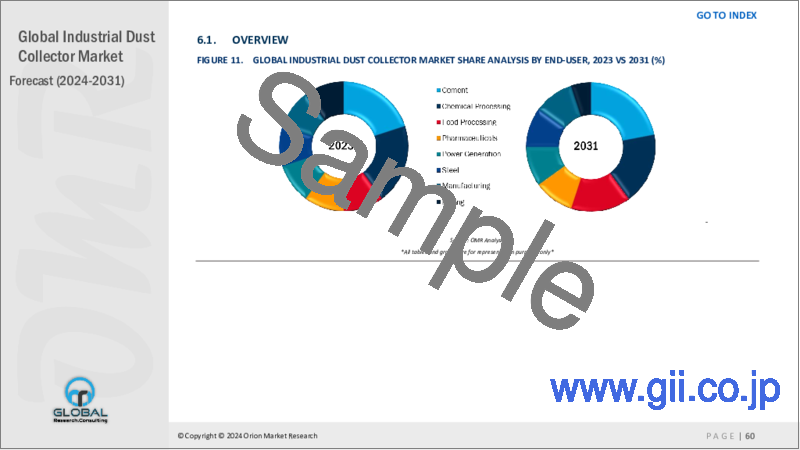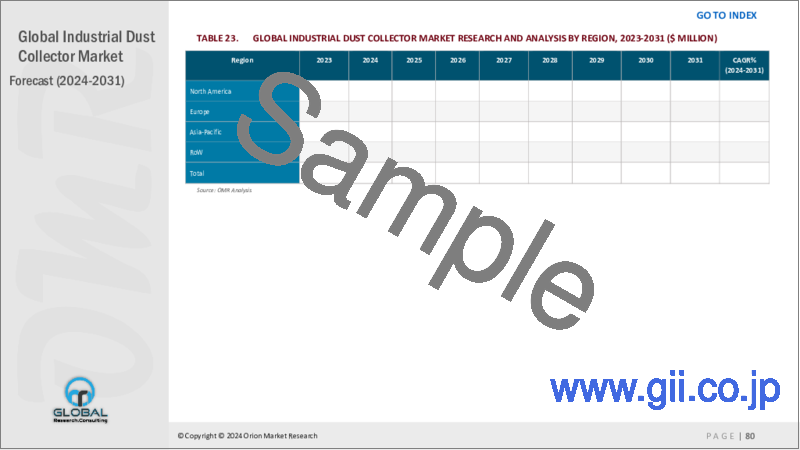|
|
市場調査レポート
商品コード
1527029
産業用集塵機の世界市場:2024年~2031年Global Industrial Dust Collector Market 2024-2031 |
||||||
カスタマイズ可能
|
|||||||
| 産業用集塵機の世界市場:2024年~2031年 |
|
出版日: 2024年07月23日
発行: Orion Market Research
ページ情報: 英文 145 Pages
納期: 2~3営業日
|
全表示
- 概要
- 図表
- 目次
産業用集塵機市場は予測期間(2024-2031年)にCAGR 4.5%で成長すると予測されます。産業用集塵機は、工場、プラント、倉庫、その他の産業または商業環境で、環境および職場の安全要件を満たすために使用される大気汚染防止装置の一種です。新興経済諸国における急速な工業化と都市化が、産業用集塵機の需要を世界的に牽引しています。
市場力学
製造業の増加
製造業の成長により、産業用集塵機の需要が急増しています。これらの集塵機は、作業員を粉塵暴露から保護し、より健康的な作業環境を確保し、健康リスクを低減するのに役立ちます。また、製品の品質を守り、汚染を防止し、製品のリコールを減らします。制御されていない粉塵は、機械の故障や生産の遅れを引き起こし、作業効率に影響を与えます。さらに、粉塵が大気中に放出される前に捕集することで、製造業者が環境規制を遵守し、よりクリーンな空気と持続可能な環境に貢献します。製造業が繁栄を続ける中、産業用集塵機市場は大きく成長すると予想されます。
職場における清浄な空気への需要の高まり
産業環境における浮遊粉塵の健康リスクに対する意識の高まりが、産業用集塵機のニーズを後押ししています。これらの装置は健康リスクを低減するだけでなく、作業員の士気や生産性も向上させる。世界中の規制機関がより厳しい空気品質基準を制定しており、集塵機は企業がこれらの基準に準拠するのに役立っています。きれいな空気に投資することは、労働者の健康と安全に対するコミットメントを示し、優秀な人材を惹きつけ、維持することにつながります。ほこりを含んだ空気は生産工程にも悪影響を及ぼし、摩耗や破損の増加、潜在的な故障につながります。産業用集塵機は、より安全で、より健康的で、より生産的な産業環境に貢献します。例えば、2023年5月、LIGNA Nedermanは独自のNederman SAVEソリューションを発表し、より安全で、より効率的で、より収益性の高い未来への道を開くのに役立つ、集塵システムのよりスマートなアプローチを紹介しました。このソリューションは、エネルギー効率の改善、安全衛生リスクの低減、法規制の遵守、生産性の向上を支援します。
市場セグメンテーション
- タイプ別では、市場はバグハウスダストコレクター、カートリッジダストコレクター、ESP、慣性セパレーター、ウェットスクラバーに区分されます。
- エンドユーザー別では、セメント、化学処理、食品処理、医薬品、発電、鉄鋼、製造、鉱業に区分されます。
工業用バイオテクノロジーが最大セグメントとして浮上すると予測
バッグハウス集塵機分野は、幅広い粉塵や浮遊粒子を処理するソリューションの多用途性と費用対効果により、市場の最大シェアを占めると予想されます。木工、化学生産、セメント製造、発電など、さまざまな産業プロセスに組み込むことができます。バグハウスは、さまざまな集塵ニーズに対してワンストップ・ソリューションを提供し、初期投資が少なく、メンテナンスコストも管理しやすいです。また、高い濾過効率で浮遊粒子を捕捉し、排出ガスを削減し、よりクリーンな環境に貢献します。バグハウスシステムは、対象とする粉塵の種類に応じてカスタマイズが可能で、中核となる機能はシンプルであるため、操作やメンテナンスが容易です。
エネルギー主導型セグメントが大きな市場シェアを占める
セメント工場では、作業員に健康上のリスクをもたらし、工場内の視認性を低下させる粉塵汚染に対処するため、環境規制の導入が進んでいます。産業用集塵機は、大気中に放出される前に粉塵粒子の大部分を捕捉することで、セメント工場がこれらの規制に準拠するのを助ける。これは、セメント工場が環境規制を遵守し、よりきれいな空気に貢献するのに役立ちます。粉塵は、健康や環境の問題だけでなく、経済的な問題でもあります。制御されていない粉塵は、機械の摩耗や損傷を増加させ、生産効率に影響を与え、メンテナンスコストを増加させるからです。さらに、捕捉された粉塵の一部は生産工程に再導入され、原材料の必要性を減らし、資源効率を向上させることができます。このように、集塵機は、労働者の健康と環境を守り、生産効率を改善するために、セメント工場にとって不可欠な投資です。
地域別展望
産業用集塵機の世界市場は、北米(米国、カナダ)、欧州(英国、イタリア、スペイン、ドイツ、フランス、その他欧州地域)、アジア太平洋地域(インド、中国、日本、韓国、その他アジア太平洋地域)、世界のその他の地域(中東とアフリカ、南米)を含む地域別にさらに区分されます。
産業用集塵機市場に投資するアジア太平洋諸国
- インドでは、各国政府によるインフラ分野への投資の増加が鉄鋼・セメント産業に大きな影響を与えており、これが市場を牽引しています。
- 中国は、最終用途産業が存在し、世界最大の鉄鋼メーカーであることから、主要地域市場の1つとなっています。
北米が主要市場シェアを占める
すべての地域の中で北米が大きなシェアを占めているのは、大気質と排出基準を管理する環境規制が確立されているためです。環境保護庁(EPA)などの州および連邦当局は、粒子状物質を含む空気中の汚染物質を削減するための規制を実施しています。産業用集塵機は、排出を最小限に抑え、法律上の問題を回避しようとする企業の結果として、高い需要があります。北米には、製造業、鉱業、建設業、化学処理業など数多くの部門があります。集塵システムは、生産活動中に発生する粉塵やその他の空気汚染物質を規制するために必要であり、この地域の産業活動の継続的な成長と拡大がこの必要性に拍車をかけています。
目次
第1章 レポート概要
- 業界の現状分析と成長ポテンシャルの展望
- 調査方法とツール
- 市場内訳
- セグメント別
- 地域別
第2章 市場概要と洞察
- 調査範囲
- アナリストの洞察と現在の市場動向
- 主要市場動向
- 推奨事項
- 結論
第3章 競合情勢
- 主要企業分析
- Thermax, Ltd.
- 概要
- 財務分析
- SWOT分析
- 最近の動向
- Donaldson Group
- 会社概要
- 財務分析
- SWOT分析
- 最近の動向
- FLSmidth Cement A/S
- 概要
- 財務分析
- SWOT分析
- 最近の動向
- 主要戦略分析
第4章 市場セグメンテーション
- 産業用集塵機の世界市場:タイプ別
- バッグハウス集塵機
- カートリッジ集塵機
- 電気集塵装置(ESP)
- 慣性分離器
- 湿式スクラバー
- 産業用集塵機の世界市場:エンドユーザー別
- セメント
- 化学処理
- 食品加工
- 製薬
- 発電
- 鉄鋼
- 製造業
- 鉱業
第5章 地域分析
- 北米
- 米国
- カナダ
- 欧州
- 英国
- ドイツ
- イタリア
- スペイン
- フランス
- その他欧州
- アジア太平洋
- 中国
- インド
- 日本
- 韓国
- その他アジア太平洋地域
- 世界のその他の地域
- ラテンアメリカ
- 中東・アフリカ
第6章 企業プロファイル
- AAF International
- Airflow Systems
- Baghouse America
- Camfil APC
- CECO Environmental Corporation
- Clarcor Industrial Air
- Dynavac India Pvt. Ltd.
- Hamun Aria Industrial Development Group
- Imperial Systems, Inc.
- Keller USA Inc.
- Nederman Holding AB
- Noes Air Filtration
- Parker Hannifin Corporation
- Schenck Process Europe GmbH
- SLY, LLC.
- Teldust A/S
LIST OF TABLES
- 1. Global Industrial Dust Collector Market Research And Analysis By Type, 2023-2031 ($ Million)
- 2. Global Industrial Baghouse Dust Collector Market Research And Analysis By Region, 2023-2031 ($ Million)
- 3. Global Industrial Cartridge Dust Collector Market Research And Analysis By Region, 2023-2031 ($ Million)
- 4. Global Industrial Esp Dust Collector Market Research And Analysis By Region, 2023-2031 ($ Million)
- 5. Global Industrial Inertial Separators Dust Collector Market Research And Analysis By Region, 2023-2031 ($ Million)
- 6. Global Industrial Wet Scrubbers Dust Collector Market Research And Analysis By Region, 2023-2031 ($ Million)
- 7. Global Industrial Dust Collector Market Research And Analysis By End-User, 2023-2031 ($ Million)
- 8. Global Industrial Dust Collector For Cement Market Research And Analysis By Region, 2023-2031 ($ Million)
- 9. Global Industrial Dust Collector For Chemical Processing Market Research And Analysis By Region, 2023-2031 ($ Million)
- 10. Global Industrial Dust Collector For Food Processing Market Research And Analysis By Region, 2023-2031 ($ Million)
- 11. Global Industrial Dust Collector For Pharmaceuticals Market Research And Analysis By Region, 2023-2031 ($ Million)
- 12. Global Industrial Dust Collector For Power Generation Market Research And Analysis By Region, 2023-2031 ($ Million)
- 13. Global Industrial Dust Collector For Steel Market Research And Analysis By Region, 2023-2031 ($ Million)
- 14. Global Industrial Dust Collector For Manufacturing Market Research And Analysis By Region, 2023-2031 ($ Million)
- 15. Global Industrial Dust Collector For Mining Market Research And Analysis By Region, 2023-2031 ($ Million)
- 16. Global Industrial Dust Collector Market Research And Analysis By Region, 2023-2031 ($ Million)
- 17. North American Industrial Dust Collector Market Research And Analysis By Country, 2023-2031 ($ Million)
- 18. North American Industrial Dust Collector Market Research And Analysis By Type, 2023-2031 ($ Million)
- 19. North American Industrial Dust Collector Market Research And Analysis By End-User, 2023-2031 ($ Million)
- 20. European Industrial Dust Collector Market Research And Analysis By Country, 2023-2031 ($ Million)
- 21. European Industrial Dust Collector Market Research And Analysis By Type, 2023-2031 ($ Million)
- 22. European Industrial Dust Collector Market Research And Analysis By End-User, 2023-2031 ($ Million)
- 23. Asia-Pacific Industrial Dust Collector Market Research And Analysis By Country, 2023-2031 ($ Million)
- 24. Asia-Pacific Industrial Dust Collector Market Research And Analysis By Type, 2023-2031 ($ Million)
- 25. Asia-Pacific Industrial Dust Collector Market Research And Analysis By End-User, 2023-2031 ($ Million)
- 26. Rest Of The World Industrial Dust Collector Market Research And Analysis By Region, 2023-2031 ($ Million)
- 27. Rest Of The World Industrial Dust Collector Market Research And Analysis By Type, 2023-2031 ($ Million)
- 28. Rest Of The World Industrial Dust Collector Market Research And Analysis By End-User, 2023-2031 ($ Million)
LIST OF FIGURES
- 1. Global Industrial Dust Collector Market Share By Type, 2023 Vs 2031 (%)
- 2. Global Industrial Baghouse Dust Collector Market Share By Region, 2023 Vs 2031 (%)
- 3. Global Industrial Cartridge Dust Collector Market Share By Region, 2023 Vs 2031 (%)
- 4. Global Industrial Esp Dust Collector Market Share By Region, 2023 Vs 2031 (%)
- 5. Global Industrial Inertial Separators Dust Collector Market Share By Region, 2023 Vs 2031 (%)
- 6. Global Industrial Wet Scrubbers Dust Collector Market Share By Region, 2023 Vs 2031 (%)
- 7. Global Industrial Dust Collector Market Share By End-User, 2023 Vs 2031 (%)
- 8. Global Industrial Dust Collector For Cement Market Share By Region, 2023 Vs 2031 (%)
- 9. Global Industrial Dust Collector For Chemical Processing Market Share By Region, 2023 Vs 2031 (%)
- 10. Global Industrial Dust Collector For Food Processing Market Share By Region, 2023 Vs 2031 (%)
- 11. Global Industrial Dust Collector For Pharmaceuticals Market Share By Region, 2023 Vs 2031 (%)
- 12. Global Industrial Dust Collector For Power Generation Market Share By Region, 2023 Vs 2031 (%)
- 13. Global Industrial Dust Collector For Steel Market Share By Region, 2023 Vs 2031 (%)
- 14. Global Industrial Dust Collector For Manufacturing Market Share By Region, 2023 Vs 2031 (%)
- 15. Global Industrial Dust Collector For Mining Market Share By Region, 2023 Vs 2031 (%)
- 16. Global Industrial Dust Collector Market Share By Region, 2023 Vs 2031 (%)
- 17. US Industrial Dust Collector Market Size, 2023-2031 ($ Million)
- 18. Canada Industrial Dust Collector Market Size, 2023-2031 ($ Million)
- 19. UK Industrial Dust Collector Market Size, 2023-2031 ($ Million)
- 20. France Industrial Dust Collector Market Size, 2023-2031 ($ Million)
- 21. Germany Industrial Dust Collector Market Size, 2023-2031 ($ Million)
- 22. Italy Industrial Dust Collector Market Size, 2023-2031 ($ Million)
- 23. Spain Industrial Dust Collector Market Size, 2023-2031 ($ Million)
- 24. Rest Of Europe Industrial Dust Collector Market Size, 2023-2031 ($ Million)
- 25. India Industrial Dust Collector Market Size, 2023-2031 ($ Million)
- 26. China Industrial Dust Collector Market Size, 2023-2031 ($ Million)
- 27. Japan Industrial Dust Collector Market Size, 2023-2031 ($ Million)
- 28. South Korea Industrial Dust Collector Market Size, 2023-2031 ($ Million)
- 29. Rest Of Asia-Pacific Industrial Dust Collector Market Size, 2023-2031 ($ Million)
- 30. Latin America Industrial Dust Collector Market Size, 2023-2031 ($ Million)
- 31. Middle East And Africa Industrial Dust Collector Market Size, 2023-2031 ($ Million)
Industrial Dust Collector Market Size, Share & Trends Analysis Report by Type (Baghouse Dust Collector, Cartridge Dust Collector, Electrostatic Precipitator (ESP), Inertial Separators, and Wet Scrubbers), and by End-user (Cement, Chemical Processing, Food Processing, Pharmaceuticals, Power Generation, Steel, Manufacturing, and Mining) Forecast Period (2024-2031)
Industrial dust collector market is anticipated to grow at a CAGR of 4.5% during the forecast period (2024-2031). An industrial dust collector is a type of air pollution control equipment used in factories, plants, warehouses, and other industrial or commercial settings to meet environmental and workplace safety requirements. Rapid industrialization and urbanization in developing economies drive the demand for industrial dust collectors globally.
Market Dynamics
Increasing Manufacturing Industries
The growth of manufacturing industries has led to a surge in the demand for industrial dust collectors. These collectors help protect workers from dust exposure, ensuring a healthier work environment and reducing health risks. They also safeguard product quality, preventing contamination and reducing product recalls. Uncontrolled dust can cause machinery breakdowns and production delays, affecting operational efficiency. Additionally, they help manufacturers comply with environmental regulations by capturing dust before it enters the atmosphere, contributing to cleaner air and a more sustainable environment. As manufacturing continues to thrive, the industrial dust collector market is expected to grow significantly.
Growing Demand for Clean Air in Workplaces
The increasing awareness of the health risks of airborne dust in industrial settings is driving the need for industrial dust collectors. These devices not only reduce health risks but also improve worker morale and productivity. Regulatory bodies worldwide are enacting stricter air quality standards, and dust collectors help companies comply with these standards. Investing in clean air demonstrates a commitment to worker health and safety, attracting and retaining top talent. Dust-laden air can also negatively impact production processes, leading to increased wear and tear and potential malfunctions. Industrial dust collectors contribute to a safer, healthier, and more productive industrial environment. For instance, in May 2023, LIGNA Nederman launched the unique Nederman SAVE solution and showcased a smarter approach to dust collection systems that helps pave the way for a safer, more efficient, and more profitable future. It helps to improve energy efficiency, reduce health and safety risks, ensure compliance with regulations, and boost productivity.
Market Segmentation
- Based on type, the market is segmented into baghouse dust collectors, cartridge dust collectors, ESP, inertial separators, and wet scrubbers.
- Based on end-users, the market is segmented into cement, chemical processing, food processing, pharmaceuticals, power generation, steel, manufacturing, and mining.
Industrial Biotechnology is Projected to Emerge as the Largest Segment
The baghouse dust collector segment is expected to hold the largest share of the market due to the versatility and cost-effectiveness of solutions for handling a wide range of dust and airborne particles. They can be integrated into various industrial processes, including woodworking, chemical production, cement manufacturing, and power generation. Baghouses offer a one-stop solution for various dust collection needs, with lower initial investment and manageable maintenance costs. They also capture high filtration efficiency, trapping airborne particles, reducing emissions, and contributing to a cleaner environment. Baghouse systems offer customization based on the specific type of dust being targeted, and their core functionality is straightforward, making operation and maintenance easier.
Energy Driven Segment to Hold a Considerable Market Share
Cement plants are increasingly implementing environmental regulations to combat dust pollution, which poses health risks to workers and reduces visibility within the factory. Industrial dust collectors help cement plants comply with these regulations by capturing a significant portion of dust particles before they escape into the atmosphere. This helps cement plants comply with environmental regulations and contributes to cleaner air. Dust is not only a health and environmental concern but also a financial one, as uncontrolled dust can lead to increased wear and tear on machinery, impacting production efficiency and increasing maintenance costs. Additionally, some captured dust can be reintroduced back into the production process, reducing the need for raw materials and improving resource efficiency. Thus, dust collectors are essential investments for cement plants to safeguard worker's health, and the environment, and improve production efficiency.
Regional Outlook
The global industrial dust collector market is further segmented based on geography including North America (the US, and Canada), Europe (UK, Italy, Spain, Germany, France, and the Rest of Europe), Asia-Pacific (India, China, Japan, South Korea, and Rest of Asia-Pacific), and the Rest of the World (the Middle East & Africa, and Latin America).
Asia-Pacific countries to invest in the industrial dust collector market
- The increasing investments in the infrastructure sector in India by governments are significantly impacting the steel and cement industry, which, in turn, drives the market.
- China is one of the major regional markets due to the presence of end-use industries and the largest steel manufacturer globally.
North America Holds Major Market Share
Among all the regions, North America holds a significant share due to well-established environmental regulations governing air quality and emissions standards. State and federal authorities such as the Environmental Protection Agency (EPA) enforce regulations to reduce airborne pollutants, including particulate matter. Industrial dust collectors are in high demand as a result of businesses trying to minimize emissions and stay out of trouble with the law. Numerous sectors, such as manufacturing, mining, construction, and chemical processing, are based in North America. Dust collection systems are necessary to regulate dust and other airborne pollutants produced during production operations, and this need is fueled by the region's industrial activity's ongoing growth and expansion.
Market Players Outlook
The major companies serving the global industrial dust collector market include CECO Environmental Corp., Donaldson Group, FLSmidth Cement A/S, Parker Hannifin Corporation, and Nederman, among others. The market players are increasingly focusing on business expansion and product development by applying strategies such as collaborations, mergers and acquisitions to stay competitive in the market. For instance, in November 2022, Camfil Air Pollution Control, a global manufacturer of industrial dust and mist collection systems, announced plans to build a groundbreaking innovative manufacturing and office building.
Table of Contents
1. Report Summary
- Current Industry Analysis and Growth Potential Outlook
- 1.1. Research Methods and Tools
- 1.2. Market Breakdown
- 1.2.1. B y Segments
- 1.2.2. By Region
2. Market Overview and Insights
- 2.1. Scope of the Report
- 2.2. Analyst Insight & Current Market Trends
- 2.2.1. Key Market Trends
- 2.2.2. Recommendations
- 2.2.3. Conclusion
3. Competitive Landscape
- 3.1. Key Company Analysis
- 3.2. Thermax, Ltd.
- 3.2.1. Overview
- 3.2.2. Financial Analysis
- 3.2.3. SWOT Analysis
- 3.2.4. Recent Developments
- 3.3. Donaldson Group
- 3.3.1. Overview
- 3.3.2. Financial Analysis
- 3.3.3. SWOT Analysis
- 3.3.4. Recent Developments
- 3.4. FLSmidth Cement A/S
- 3.4.1. Overview
- 3.4.2. Financial Analysis
- 3.4.3. SWOT Analysis
- 3.4.4. Recent Developments
- 3.5. Key Strategy Analysis
4. Market Segmentation
- 4.1. Global Industrial Dust Collector Market by Type
- 4.1.1. Baghouse Dust Collector
- 4.1.2. Cartridge Dust Collector
- 4.1.3. Electrostatic Precipitator (ESP)
- 4.1.4. Inertial Separators
- 4.1.5. Wet Scrubbers
- 4.2. Global Industrial Dust Collector Market by End-User
- 4.2.1. Cement
- 4.2.2. Chemical Processing
- 4.2.3. Food Processing
- 4.2.4. Pharmaceuticals
- 4.2.5. Power Generation
- 4.2.6. Steel
- 4.2.7. Manufacturing
- 4.2.8. Mining
5. Regional Analysis
- 5.1. North America
- 5.1.1. United States
- 5.1.2. Canada
- 5.2. Europe
- 5.2.1. UK
- 5.2.2. Germany
- 5.2.3. Italy
- 5.2.4. Spain
- 5.2.5. France
- 5.2.6. Rest of Europe
- 5.3. Asia-Pacific
- 5.3.1. China
- 5.3.2. India
- 5.3.3. Japan
- 5.3.4. South Korea
- 5.3.5. Rest of Asia-Pacific
- 5.4. Rest of the World
- 5.4.1. Latin America
- 5.4.2. Middle East & Africa
6. Company Profiles
- 6.1. AAF International
- 6.2. Airflow Systems
- 6.3. Baghouse America
- 6.4. Camfil APC
- 6.5. CECO Environmental Corporation
- 6.6. Clarcor Industrial Air
- 6.7. Dynavac India Pvt. Ltd.
- 6.8. Hamun Aria Industrial Development Group
- 6.9. Imperial Systems, Inc.
- 6.10. Keller USA Inc.
- 6.11. Nederman Holding AB
- 6.12. Noes Air Filtration
- 6.13. Parker Hannifin Corporation
- 6.14. Schenck Process Europe GmbH
- 6.15. SLY, LLC.
- 6.16. Teldust A/S






